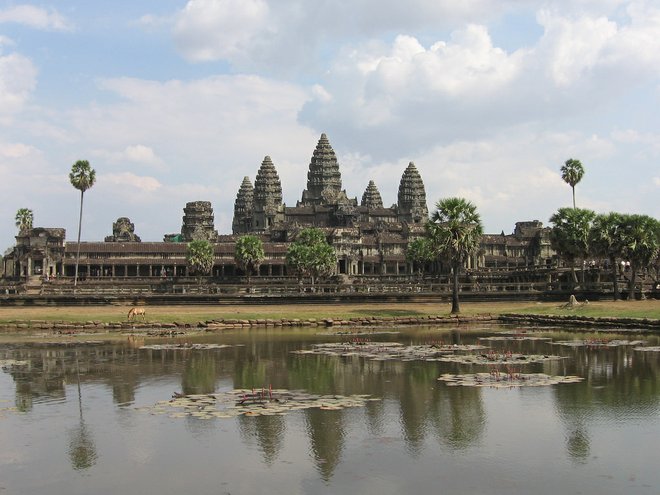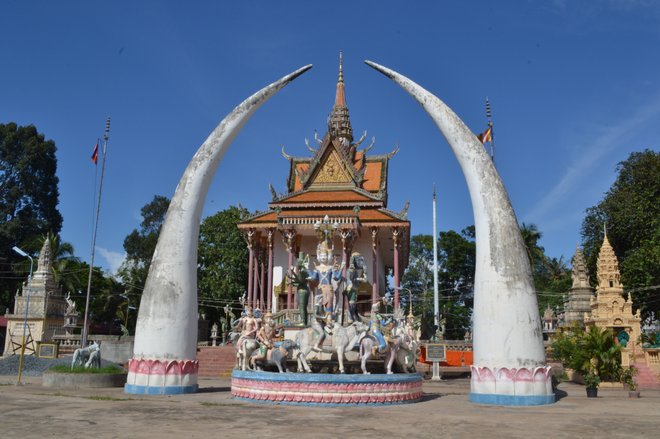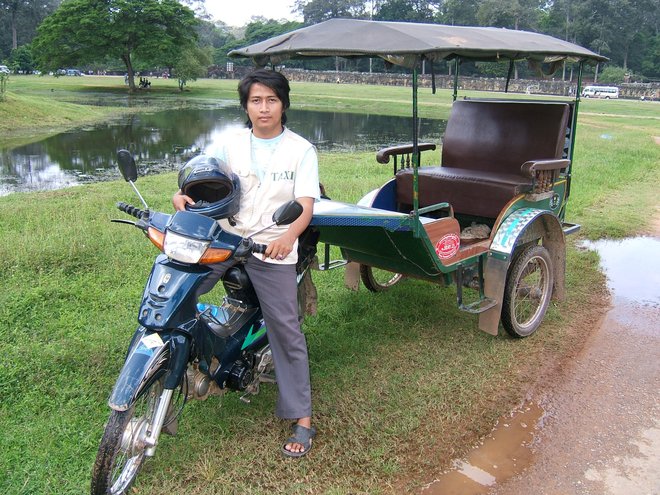
Teeny Cambodia, nestled between touristic heavy-hitters, Vietnam and Thailand, is a country in transformation. Cambodia has only recently emerged from the horrors of war and genocide and opened itself to visitors with a smile and “sampeah” (a formal greeting where one places his palms together in a prayer-like fashion, accompanied with a slight bow). Although there has been much progress, many visible -- and hidden -- scars from the past remain. Many Cambodians lost many friends and family members, as nearly a quarter of the population perished under the Khmer Rouge’s reign from 1975 to 1979. Some remote places are still riddled with landmines, and bomb craters can be found near the Vietnam border. Despite the atrocities, the Cambodian spirit endures, and the peace now matches the calm beauty of the sunrise over what appears to be a never-ending sea of bright green rice fields.
Today, the Kingdom of Wonder is ripe for the adventurous traveler. The capital city, Phnom Penh, offers a more manageable Asian metropolis compared to some of its neighbors. The bustling avenues are easily navigated by “tuk tuks” (covered passenger carts pulled by motorbikes) and the markets teem with fresh fruit and sizzling street food. Soon after leaving Phnom Penh, visitors discover that the countryside unfolds into rural communities on dry slivers of land amongst rice fields dotted with palm trees. They can continue moving outwards to discover the lush vegetation and rolling mountains, which serve as home for Asian elephants, sun bears, and more. Sound great? It is! But before you book that flight, take a look at our list of need to know things before visiting Cambodia.
Angkor Wat. Courtesy of Flickr/saritravels
1. Hot season is really, really hot.
The climate is dictated by the monsoon rains. This divides the year into roughly four seasons: late November to February is cool and dry, March to May is hot and dry, June to August is hot and wet, September to Early November is cool and wet. Temperatures during the hot and dry season can soar well above 100 degrees Fahrenheit, and with little rain in the preceding months, everything is coated in a fine layer of dust. November through February is the most pleasant time to visit, with highs in the 80s and 90s — yes, that’s considered “cool.”
2. Cambodia has a recent tragic history.
The Khmer Rouge was a communist regime that seized power in Cambodia in 1975 and endeavored to transition to a pure agrarian society. This materialized with the evacuation of cities and the imprisonment, torture, and murder of educated people, such as monks, teachers, and artists. When Vietnamese forces swept through in 1979 to oust the Khmer Rough, nearly 2 million Cambodians (of a total population of 8 million) had died under the Khmer Rouge. A visit to the genocide museum at Tuol Sleng in Phnom Penh offers an informative and chilling look into Cambodia’s most infamous torture center. For those interested in a more removed exposure, “The Killing Fields” and “The Missing Picture” are two films which capture the tragic history.
Visitors should be aware of the West’s role in the conflict. The United States’ military involvement in Vietnam and meddling in Cambodian politics made the U.S. complicit in allowing the Khmer Rouge to rally support. During the Vietnam War era, the United States dropped more explosive ordinance on Cambodia than was used by the Allied Forces in the entirety of World War II. No one has any idea how many people were killed in these attacks, but it is known that this radicalized the population of a neutral country. Additionally, the U.S. supported an authoritarian military regime, lead by Lon Nol, who maintained control of the urban centers until 1975. The Khmer Rouge harnessed the rage and resentment from these atrocities, and ultimately gained control of the small country. Despite this recent history, foreigners are typically met with warmth, or perhaps some shy curiosity, at worst.
3. Cambodian culture is defined by much more than the Khmer Rouge.
Before these atrocities were committed, Cambodia had been experiencing a flourishing music and arts scene from the ’60s into the early ’70s. Musicians like Ros Sereysothea and Sinn Sisamouth were producing music on par with their peers in the United Kingdom and the United States. The soulful voices and funky surfer rock beats give insight into the cosmopolitan life that the Khmer Rouge sought to dismantle. Going much further back in history, before the 10th century, the Angkor Empire ruled a region much larger than modern day Cambodia. This empire is responsible for the construction of the vast and intricate temple complex of Angkor, which is the largest religious monument in the world. (You can stay near the complex in Siem Reap.) Cambodians are very proud of their ancient history and temples, which can be found in all corners of the country.
4. Cambodia is a majority Buddhist country.

Golden spires and pitched roofs emerge throughout the urban sprawl of Phnom Penh and rise above the palm tree covered countryside. These structures are called “wats” by Cambodians, or pagodas in English. They serve as a home for monks, a place of worship, and cultural centers for Cambodia’s Buddhists, who comprise 95 percent of the population. Each morning visitors will see orange robe–clad monks making their way through the streets to accept food offerings from worshippers. Additionally, if you’re fortunate enough to visit during a Cambodian holiday (there are many), the celebrations will likely include a lively ceremony or party at the pagoda with upbeat pop music loud enough to leave your ears ringing.
5. Be wary of volunteering, as you might inadvertently support a deceitful company or bad cause.
There has been an increasing sentiment among tourists of wanting to give back or volunteer while traveling. It is encouraging to see this, but at times, good intentions can be misguided or tricked by opportunistic frauds. This is most exemplified in Cambodia by exploitative orphanages. Over 12,000 children live in orphanages in Cambodia, but the number of actual orphans is only one-fifth of that figure. Illegitimate institutions prey on poor families who believe their children will receive an education and promising future there. With the risk of abuse and mistreatment at these orphanages, children might develop mental and emotional problems. Their relationships and encounters with tourists are very short-term, which might not benefit the them greatly. Your time and money would be better spent supporting legitimate operations. There are many great organizations supporting Cambodian youth that raise funds through cafes, shops, and artistic performances. Instead of volunteering at an orphanage, consider seeing a musical dance performance by Epic Arts or an acrobatic splendor at the Phare Ponleu Selpak’s performing circus.
6. You don’t need to exchange your U.S. dollars into Cambodian riels.
The official currency is the Cambodian riel, which trades at approximately 4,000 riel to the U.S. dollar. However, the U.S. dollar is widely used, and most prices for tourism are quoted in dollars instead of riel. In fact, the visa you purchase on arrival must be paid for in U.S. dollars. Often, you will receive change back in riels — probably in 2,000 and 1,000 notes. We recommend bringing a stash of crisp U.S. dollar bills in denominations less than $20. These will be useful to pay for tuk tuk rides (averaging $2–4) and market purchases. American bills with even the slightest blemish will typically not be accepted.
7. You should allocate plenty of time for transportation.
A driver with his tuk tuk. Courtesy of Flickr/shankar s.
The Cambodian national highway system is in the process of being upgraded. However, most of the highways are no more than a two-lane road, and it is not uncommon to see oxcarts, stray cattle, and dogs crossing the fray, so the going might be slow. For example, Cambodia’s second largest city, Battambang, is under 200 miles from Phnom Penh via national road 5. But travelers should expect this relatively short journey to take approximately five hours by car and seven by bus. Local modes of transportation include the nifty tuk tuk, which seats up to 4 people in its covered carriage behind the driver’s motorbike. A less practical, but worthwhile option is to ride in the front seat of a Cambodian cyclo (essentially a tricycle with a seat for passengers attached between the front wheels). It’s a leisurely, historic way to take in the bustling capital.
You’ll Also Like:
- Where to Go in Thailand: A Complete Guide to the Most Popular Destinations
- What It’s Like to Throw Out Your Itinerary and Explore Vietnam
- 5 Awesome Budget Destinations in Asia
All products are independently selected by our writers and editors. If you buy something through our links, Oyster may earn an affiliate commission.



